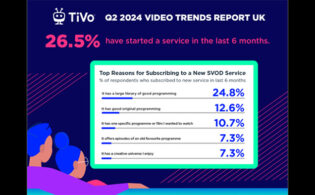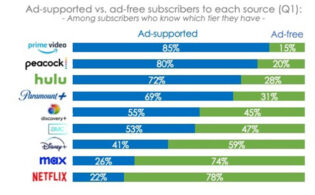Consulting firm Magid has released new findings from its analytics-driven tool SubScape, which points to a difference between “bad” churn and “strategic” churn when it comes to streaming services.
According to Magid’s SubScape, between January and October 2023, the top 20 streaming services, on average, experienced a subscriber loss of 8 percent and a gain of 8 percent per month, realizing an average net growth of zero in the U.S.
While subscriber volatility across the landscape is high, with 40 percent on average saying they may cancel or are likely to cancel the individual paid service used by their home in the next year, Magid’s SubScape data finds that not all churn is bad and that some attractive psychographic segments, predisposed to churn, “provide a competitive advantage and guide streamers toward increased market share and profitability when managed strategically.”
It divides groups as Hypers (a high churn, high income segment whose value lies in driving growth and word of mouth); Loyalists (a high spending low churn segment); Digitarians (a high churn segment with equal interest in video on social platforms like YouTube and TikTok, they’re free promotion seekers who do not represent a high ROI on marketing dollars); Pragmatics (a smaller segment that is a critical revenue-driver for certain services with libraries that map to its emotional needs); Mainstreamers (a laggard segment, but a low churn group that is an important component of stability in a mature SVOD, but rarely strays beyond the top five services); and Inerts (the oldest of six segments, with a lower interest in video overall, Inerts present the lowest opportunity to drive revenue).
Additionally, the Magid finds that not all churn is equal. It asserts that there is a difference between “bad” churn and “strategic” churn, with the latter consistent with strong long-term growth. “While perceived service weakness may play a role in churn, churn is often fueled by a segment’s inherent volatility and the attitudes/behaviors that subscribers, like Hypers, bring with them, such as a fear of missing out. Services that consistently deliver culturally relevant content will attract these transient FOMOs.”
Some high-churn segments show value in other ways, according to the report. “With new content driving interest, a service’s vibrancy and health is in part measured by its appeal to some high-churn viewers. And one of these high-churn segments, Hypers, carry the most number of services at any given time and are also the best word-of-mouth drivers in a streamer’s customer base.”
Income and churn don’t always go hand in hand, the report also finds. “Although it might seem counter-intuitive, having less disposable household income isn’t always predictive of churn propensity. Hypers, the highest-income SubScape segment, also has a high proclivity to churn.”
It also says that we’re looking at the wrong metrics. “Traditionally, average subscriber tenure and churn rates were an indicator of business health. But research suggests the more accurate metric is the number of total subscribed months (whether or not they’re contiguous), which recognizes that some subscribers who leave quickly also come back quickly.”
Brent Magid, CEO, and Kate Morgan, chief product officer and head of the Global Media, Entertainment and Games practice, said: “The media industry is at an inflection point as savvy consumers are presented with an unending list of viewing options.” They added: “The battle for the acquisition and retention of churn-centric subscribers isn’t slowing down, which is why leveraging SubScape’s granular, solution-based insights have been mission-critical for our clients as they reimagine their streaming playbook for long-term growth.”




